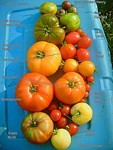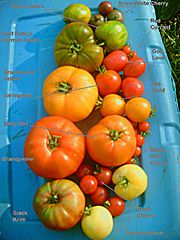With the recent resurgence of farmers’ markets and renewed interest in seasonal eating, it’s easy to take good tomatoes for granted. But a recent experience made me really appreciate good tomatoes. I ordered a BLT at a restaurant, and for some reason the chef made it with raw green tomatoes. It was awful! If the chef had only fried or grilled the green tomatoes, the sandwich would have been awesome.
How to Buy
As beautiful as tomatoes can be, the true test is in tasting them. That’s easy enough to do at the farmers’ market, but you have to be a little proactive in the supermarket. Don’t hesitate to ask a staffer to sample a tomato or two.
But you can—to a degree—judge a tomato by its cover. Tomatoes with full, saturated color all over are ideal. However, many commercial tomatoes are mechanically harvested while still green (when they are sturdier and better able to withstand travel) and later artificially ripened with ethylene gas. This treatment makes the tomato look red on the outside, but the core will still be pink; for this reason it’s useful to check out the cross-section of a cut tomato if you can. Ideally, the color will be consistent from the skin to the very center.
Buy organic tomatoes whenever possible. Most commercial tomatoes are heavily sprayed with pesticides and then treated with fungicides after harvest to prolong shelf life. Organic and unsprayed tomatoes are becoming more readily available, especially at farmers’ markets, so look for and purchase those if you can.
Tomatoes that still have a bit of green stem attached are optimal; The stems themselves have a short shelf life, as they dry and brown fairly quickly. Not only are stem-on tomatoes more work as far as picking goes, but also a bright green stem is a good sign that the tomato was recently picked.
Avoid tomatoes with split skins; it indicates a late rain or general over – watering, and that exposed flesh is vulnerable to mold.
It seems obvious to recommend buying tomatoes in season, but its importance cannot be overstated. Many folks associate tomatoes with summer, so guests start asking for them as soon as the weather warms up. However, because tomatoes are a late-planted crop (they can’t go into the ground until after the final frost), and they require an extended period of heat and sun to reach maturity, tomatoes aren’t ready for harvest until mid-July or later, depending on the weather and where you are.
Farmers’ markets are almost always the best places to find good tomatoes—but you can often find pretty good tomatoes at the supermarket if you know what to look for:
Cherry and grape tomatoes tend to be a little more flavorful than other varieties of supermarket tomatoes. Their small size makes it easy to sneak a little taste and evaluate the goods. Sungolds and Sweet 100s are a couple of varieties that tend to have good flavor.
Heirloom tomatoes are mind-boggling in their variety and proliferation. Some are utterly incredible; others are just so-so. When you’re shopping, it’s important to realize that “heirloom” refers only to the varietal category and doesn’t have anything to do with the way the tomato is grown. Some commercial growers have hopped onto the heirloom bandwagon and grow heirlooms just as they grow their other tomatoes: for size and appearance, not for flavor. So you might buy a huge, gorgeous heirloom, only to find that it’s bloated and flavorless from overwatering. They can be pricey, too—all the more reason to ask for a taste!
Roma and other “paste” tomatoes are the ideal choice for cooking if you have to buy fresh tomatoes out of season. San Marzano is my favorite variety in this category; they’re perfect for canning.
Slicer tomatoes, like Beefsteak, New Jersey and Early Girl, are so named because of their hefty size and round shape. “Vine ripe” tomatoes also fall into this category; they are generally hothouse-grown in Holland. Their flavor is decent, but not great.
Don’t forget canned tomatoes as a reasonable alternative to fresh tomatoes in the off-season. In the dead of winter, tomatoes from a can will have worlds more flavor than crunchy, underripe ones. They work perfectly if you’re going to cook the tomatoes anyway, and even make great salsas.
How to Store
Do not refrigerate tomatoes (and don’t buy refrigerated ones, either); the chill adversely affects the texture and diminishes the flavor. If you buy slightly underripe tomatoes, put them in a paper bag and let them sit on the counter for a few days; they will soften and become a bit sweeter.
How to Use
When you have really excellent tomatoes, especially organic heirlooms, all you need is a sprinkle of salt and a drizzle of high-quality extra-virgin olive oil.
Basil is a natural accompaniment to tomatoes; tarragon, thyme, oregano and cilantro are good partners.
Cherry tomatoes are excellent in salsas, tossed with tender green beans, or briefly sautéed and mixed with pasta. (For a quick meal, toss good spaghetti or linguine with sautéed tomatoes and garlic, basil, extra-virgin olive oil, and salt and pepper. Five minutes is all it takes to make the sauce, start to finish.)
Roma tomatoes are well suited to making tomato paste and sauce.
Heirlooms are at their best when you leave them raw; their subtleties and distinct personalities diminish when cooked. If you can get your hands on a few different heirloom varieties, try conducting a side-by-side tasting of your own. Pay attention to what’s happening in your mouth. You’ll find a surprising spectrum of textures, flavors, and seed structures. Some will seem incredibly sweet, and others will be almost salty.

